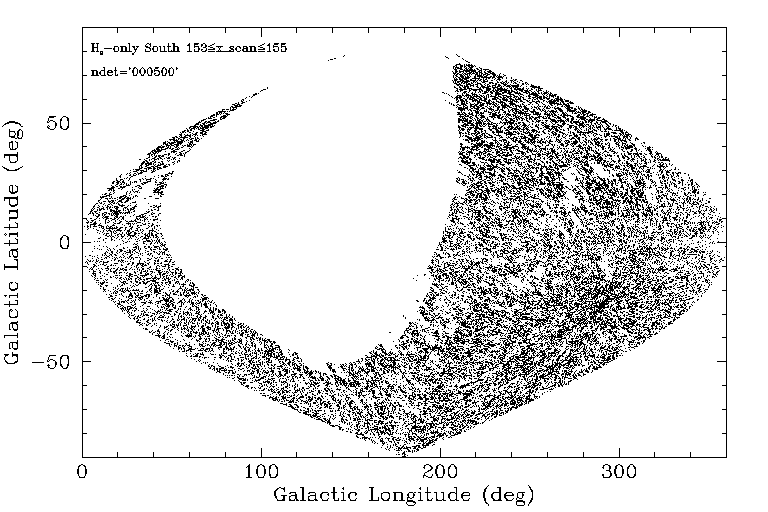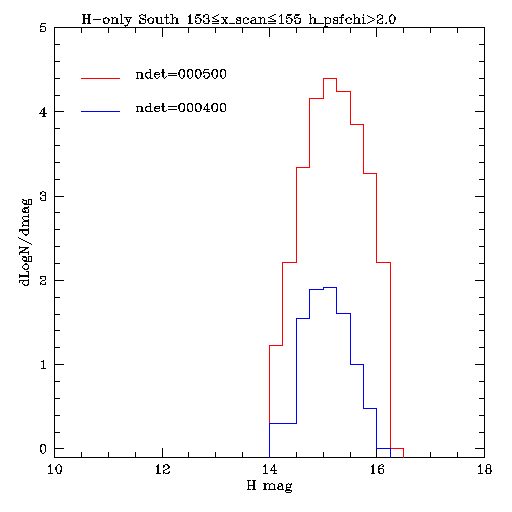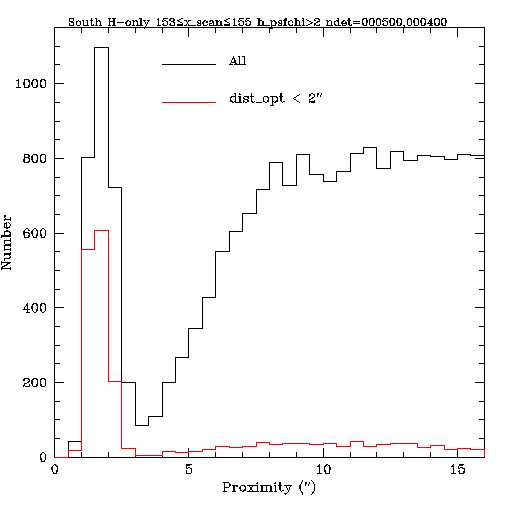I. Introduction
Analysis of single-band sources in the PSC has shown that a large number of H-only sources are spurious detections of a single hot pixel in the southern H-array. These sources are distinguished by falling in a narrow range of x_scan position, being relatively faint (H>14), having high chi-squared values, and having ndet values of "000500". Because there are large enough numbers of these spurious sources that the Level 1 Requirements for reliability are not met in the H-band, the decision has been made to delete these sources from the PSC. We summarize the general properties of the H-only sources to be removed from the PSC in this web page.
II. Selection and Statistics
Candidate sources associated with the hot pixel in the southern H-array are selected from the provisional PSC using the following query:
We add sources with ndet="000400" based on Figure 15 in the single-band source analysis page that shows a population of high chi-squared sources associated with the southern hot pixel. Tables 1 and 2 list general statistics of the candidate sources with both values of ndet. The ndet="000400" adds relatively few additional sources. For comparision, the statistics of the sources with no chi-squared limit are also shown.
There are a total of 68,815 candidate spurious hot pixel sources to be removed from the PSC. Most have ph_qual='UAU'.
Table 1 - Statistics of PSC sources with hemis = 's' AND rd_flg MATCHES '020' AND x_scan BETWEEN 153 AND 155 AND (ndet = '000500' OR ndet = '000400')
| Subset | All | ext_flg not null | gal_contam = 2 | dist_opt < 2.0 |
|---|---|---|---|---|
| ndet="000500" AND h_psfchi>2.0 | 68560 | 1 | 14 | 2702 |
| ndet="000500" | 70641 | 1 | 15 | 3092 |
| ndet="000400" AND h_psfchi>2.0 | 255 | 0 | 0 | 8 |
| ndet="000400" | 275 | 0 | 0 | 16 |
Table 2 - Ndet Stats for hot pixel candidate sources
| ph_qual | ndet="000500" | ndet="000400" |
|---|---|---|
| UAU | 58073 | 227 |
| UBU | 10040 | 26 |
| UCU | 436 | 2 |
| UDU | 11 | 0 |
Figures 1 and 2 show the sky distribution of the hot pixel candidate sources. Note that there is not an increase in the number of candidates towards the Galactic Plane. In fact, there is a drop of in the number near the Galactic Center. This occurs because the spurious hot pixel "sources" will be less likely to pop up over the detection limit in regions with the highest confusion noise.
 |
 |
| Figure 1 - Equatorial distribution of candidate hot pixel sources | Figure 2 - Galactic distribution of candidate hot pixel sources |
Figures 3 shows the brightness distribution of hot pixel candidate sources. All have H>14.0 magnitude, with the peak of the distributions near H=15.0 mags. The chi-squared distribution of all of the sources in the 153<x_scan<155 region shown in Figure 4 shows the chi-squared distribution of all of the southern H-only ndet="00050" and "000400" sources in the cross-scan range of the hot pixel. The chi-squared limit of >2.0 used to identify spurious sources is probably overly conservative. However, the relative number of sources that would be left in if a slightly smaller chi-squared limit is small, so no change is proposed.
 |
 |
| Figure 3 - Mag distributions of candidate hot pixel sources | Figure 4 - Chi-squared distributions of candidate hot pixel sources |
III. Reliability
Table 1 shows that nearly 4% of the hot pixel candidates have optical counterparts within 2". This is usually a strong reliability indicator for 2MASS sources. Should we be worried about the impact on completeness by deleting such sources from the PSC?
We visually examined the 2MASS images at the positions of 25 of the candidates that had optical counterparts within 2". Ten positions appeared blank on the images, as expected for hot pixel sources. However, the positions of 15 "sources" fell close to, but usually not exactly on the location of what appeared to be real sources visible in two or more bands. All but one of the hot pixel candidates near a real source had prox<2 indicating that the sources were detected in other bands. Cone search queries on the PSC around the positions of the hot pixel sources usually finds a source with detections in J and often Ks. However, quite often the colors of the mergers of the H-only and J/Ks sources are unusual. These are likely incidences of the hot pixel landing close to a real source and biasing the centeroid of the H-band detection far enough away from the true source location to cause a failure of the bandmerge. Hot pixels in all of the bands may be a common cause for failed bandmerges throughout the PSC.
Figure 5 shows the histograms of prox values for both the full set of hot pixel candidates, and those with optical counterparts within 2". A much larger fraction of those with optical counterparts have PSC counterparts well within the 2MASS resolution limit, suggesting these are mostly broken bandmerges due to the biasing of the hot pixels. In these instances, though, the H photometry is probably useless because of the influence of the hot pixel. Therefore, we recommend that such H-only sources still be deleted from the PSC, even though they may be associated with real sources.
 |
| Figure 5 -Prox histograms for hot pixel candidates |
IV. Impact
1. Reliability inferred from the 2MASS/SDSS comparsion
The filter shown in the query in Section II will remove 215 of the 228 H-only sources in the provisional PSC that did not have SDSS counterparts in Davy's analysis. Of the remaining 13 H-only sources without SDSS counterparts:
- all have h_psfchi>2.0
- 10 are in x_scan ranges corresponding to identified hot pixels other than the southern 153<x_scan<155 pixel.
- 3 are in the southern 153<x_scan<155 hot pixel range, but have ndet="001500"
With 13 unreliable sources, the H-band reliability based on the 2MASS/SDSS comparison is raised to 0.009%, well-within the Level 1 Specifications.
2. Filtering high chi-squared sources
The hot pixel source query applied to the sources to be added to the PSC identifies 88,851 of the ~1.3e6 sources. Of these, 88,581 have use_src=1 or use_src=0 AND dup_src=0.
Last Updated: 4 December 2002
R. Cutri (IPAC)